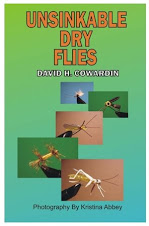Articulating
flies have been part of streamers for some time and a gentleman named Dave Hise
started appling this principle to nymphs and dry flies.. A couple of months ago
before I knew Mr. Hise was out there I started tying such flies in sizes 6 to
18 using both my unsinkable method as will as more conventional materials . The
first fly I tied and fished was a red ant which I call my Fire Articulating
Ant.
To test any new fly I generally take it to a spot on my local river that gets pounded by drift boats as well as walk in anglers. I don't always have success at such a place, but if I can catch fish here, I figure I can catch them anywhere. To my amazement the articulating ant was an outstanding success. This is what made me apply this articulating style to other flies both dry and wet as shown below. These flies have a catch rate that would make most any angler happy.
To tie such a fly use two hooks and tie the back half of the fly first. Then using a small section of something like Spiderwire (Braided Cord) in at least 15 pound test attach the back half of the fly to the forward hook that will become the front of the fly (See Below).
After wrapping the front hook shaft with your thread (shown in yellow) fold the Spiderwire back and wrap again to insure the attaching line will not separate under hookup conditions. Once the hooks are connected you can finish tying the front half of the fly. The pictures below show the actual attachment method. The last picture in the series the excess braided cord being clipped off prior to tying the front half of the fly.
The two most successful flies I have tied to date are a salmon fly nymph and my own creation the Wonder Bug shown below.























